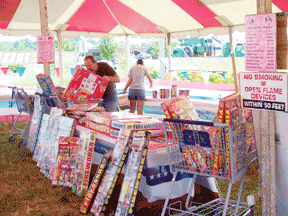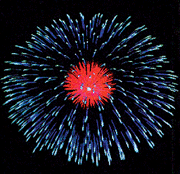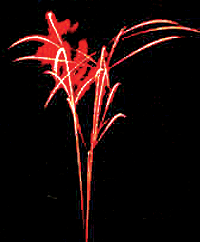The Big Bang Theory
How to stop worrying and learn to love the bombsby Diana BeechenerEach year at major events from Independence Day to New Year to monthly bursts at the Baysox or Orioles games and nightly illuminations over Walt Disney World, spectators enjoy bombs bursting in air with no fear for their safety. Fireworks have become such staples of celebrations that it’s easy to forget the glittering colors lighting up the night sky are actually carefully choreographed explosions. The big blasts are reserved for professionals in Maryland, where all but a few sparkling po ppers are banned. In spite of the limitations, cars still sidle up to roadside tents, where low-grade explosives with high-grade names such as Devil’s Delight, Nuke Power and Lil’ Patriot are packed into trunks. With $15 and a match, anyone can become a pyrotechnician. But glittering lights can quickly turn into engulfing flames.
Read on, and this Independence Day, you’ll know that the colorful patterns and vivacious lights you see are essentially precision-timed paper mache bombs — but bombs, still. Spark of InventionCultures all over the world have taken a turn playing with fire. Though there is evidence of fireworks in the Middle East, the earliest form of fireworks likely erupted nearly 2,000 years ago in China. Legend holds that an unlucky cook using a combination of flammable seasonings over an open-flame created the first big bang, leading to our modern pyrotechnics. The Chinese combined roasting bamboo shoots — which created a loud noise used to scare away evil spirits and invading forces — with the invention of black powder. Originally set off to ring in the New Year, black powder packed into bamboo shoots became a celebratory display during the Song Dynasty. The black powder was also used for propulsion, and soon hand-carved wooden rockets took to the air. Marco Polo brought back black powder and early fireworks from his travels, and Europeans further tinkered with the materials, creating refined gunpowder and bigger blasts. In the 18th century, chemicals were combined with the black powder, creating colored displays. German and Italian pyrotechnicians perfected the shells and color flashes. The first fireworks display on the Chesapeake burst forth circa 1608, when John Smith lit up the sky to impress Native Americans. Since the late 1700s, fireworks have burst forth during times of jubilation in America, becoming a staple of July 4th celebrations in the 1800s. Over 90 percent of fireworks are still manufactured in China, though the market was blasted in February when 15,000 cartons of fireworks exploded in warehouses throughout the leading shipping port of Sanshui. Anatomy of a BombA 10- to 12-inch-diameter paper-and-string ball doesn’t seem threatening, but beneath that tether-ball-like surface is a precisely packed mix of black powder, noxious chemicals and fuses. It’s no coincidence that fireworks casings — or shells — share their name with the casings of bullets and mortar rounds, for they contain similar ingredients. Manufactured from the Far East to the East Coast, fireworks burst in myriad patterns and colors, but they share a similar skeleton. Pyrotechnics Guild International’s John Steinberg spends his Junes explaining the basic anatomy of a firework. The easiest way to understand a firework is to follow the spark from fuse to detonation, so Steinberg begins with the basics. The success of every firework depends on the shell. Shells are either cylindrical or spherical, the round casings harkening to their Asian roots. The shell must be sturdy enough to contain the charges, but delicate enough to burst evenly upon detonation. Because what goes up must come down, there are further complications. “There is no hard plastic or metal in professional fireworks,” Steinberg says. Tough materials such as metal or hard plastic typically used in bullets or explosives create shrapnel, which in fireworks would rain down on eager onlookers. To stave off disaster, “it’s all paper and soft plastics. It’s all basically paper mache.” Every bomb bursting in air on Independence Day is comprised of strips of paper, paper-hanger’s paste and string — a far cry from bamboo stuffed with black powder. Once the shells are ready, according to Steinberg, things heat up. “You have to have a way to convey fire,” he says.
Got a match? Not so fast. First you have to know what kind of fuse you’re flaming. Two varieties of fuse spark the journey to ignition: a leader fuse or a quick-match fuse. Leader fuses spark recreational fireworks, requiring an operator to add flame and burning slow enough to allow the shooter time to retreat from the impending explosion. Quick-match fuses either follow the leader or, on commercial fireworks, start the show. This special fuse is soaked in a slurry of black powder, then dried and finally wrapped in paper. The fuse earns its name: Several feet of quick match will burn almost instantaneously upon ignition. This fast-burning fuse connects to the time fuse. “The time fuse burns internally, so it can take the fire inside the shell,” Steinberg explains. This internal burn keeps the fire from enveloping the shell. The fuse also “burns at a predictable rate, allowing height to be achieved before blast.” As the time fuse simmers into the guts of the shell, it ignites the lift charge, a blasting-grade black powder at the base of the firework that propels it skyward. When the time fuse times out, the flame reaches the ascending shell’s guts: a packing of burst charge and stars. “The burst charge has two functions,” Steinberg says. “One, it has to spread fire throughout the inside of the shell. The second function is to create enough pressure to burst the shell.” The burst charge is typically rice hulls or pieces of cork coated with gunpowder. Once the fire reaches the stars, the show begins. Stars are the effect-pellets nestled into every firework, providing shape and color to the explosion.
“Stars vary, but each pellet contains four elements,” says Steinberg. Each star consists of a primer, pellet, color compound and binding agent. The primer is a special mix of chemicals that helps the fire burn through the color-compound chemicals. The pellet, an oxidizer, holds potassium prochlorate, or flash powder, charcoal and a finely powdered metal. To create a rainbow of lights, pyrotechnicians pack chemicals that burn in different shades into their effect stars. Copper burns blue. Strontium salts and lithium salts burn red. Sodium burns yellow. Calcium burns orange. Barium burns green. Charcoal and lampblack burn gold. Magnesium, aluminum and titanium burn white or silver. “The elements are rolled together in a binding agent, typically dextrose, which is basically corn starch,” Steinberg says. Completed fireworks are shipped to private homes and commercial pyrotechnic warehouses, where they will join with other flares to create a matrix of carefully choreographed explosions — or chaos — this Independence Day. DetonationMaryland, and the state fire marshal, would prefer that you leave the explosions to the professionals. Reaching temperatures well over 1,000 degrees and bursting open, fireworks are a dangerous way to celebrate. Roadside stands pop up toward the end of June, selling collections of permissible fireworks — packed with low-grade explosives — in Anne Arundel and Calvert counties. Though the stands look like a traveling circus, with tents pitched along vacant lots, they are carefully regulated. Before fireworks stack the tables, local fire marshals inspect the wares. When approval is granted, the stands are subject to spot checks by fire marshals or local authorities. Under a red-and-white-striped big top tent along Route 2 in Edgewater, father and daughter team Tom and Quinn Conlan set up shop. Each day, from a giant shipping container next to the stand, the Conlans stack neon boxes emblazoned with titles like Pyro Junkie on shaded outdoor tables. Baskets filled with multi-colored mini-fireworks sit like an assortment of penny-candy. The heat inside the metal shipping container, which sits in the sun all day, doesn’t concern Tom Conlan. “They can take heat,” Conlan says with a nod to the container, “just not fire.” Conlan works the stand from June 13 through July 8, with Quinn, who has found the ultimate summer job. “My schedule is really flexible,” says Quinn, who took the just-over-three-week job as a way to earn money for college. “Since my dad is here, if I have to go somewhere, I can.” You’ll find both Conlans working their stand from 9:30am to 9:30pm each day. In spite of the provocative names on the legal fireworks, Tom Conlan doesn’t see too much danger: “Everything sold in Maryland is smoke and glitter now.” He reports that his stand draws both sexes: Women often bring small children for their first spark of Independence Day spirit. Men, Conlan says, venture by themselves or with older children, planning more sophisticated pyrotechnic shows. Even these low-grade bashes can shift from celebration to calamity quickly, though, bringing the bright lights of the fire department to backyards. Anne Arundel County’s Lothian Fire Department spells out the danger on its marquee: Leave Fireworks to the Professionals. Station Lieutenant Jim Crum says one of the shift lieutenants posted the sign because “with the proximity to the Fourth of July, there is always a potential danger.” Fireworks cause “a lot of hand injuries” Crum says. According to the federal government, fingers and hands are the first casualty of careless fireworks play, but these injuries are just the tip of the blasting cap. The federal Consumer Product Safety Commission linked 11 deaths in 2006 to faulty or improperly used fireworks — including an aerial firework that imbedded in concrete, sending shrapnel into onlookers. More than 9,200 Americans spent their Independence Day in hospital emergency wards, seeking balm for burns, cuts or more severe injuries. Even harmless looking sparklers burned some 1,000 people, causing varying degrees of damage. If the threat of injury doesn’t deter you, the complications of planning a proper pyrotechnic show might. Technicians from Zambelli fireworks start their Fourth of July months in advance. The Pennsylvania-based pyrotechnic wizards choreograph fireworks displays for Baltimore, Annapolis, Ocean City and other big cities each year. One of the men with his finger on the button — or hand on the wand — is Zambelli’s pyrotechnician Bill Gallentine, who lights up the skies over Ocean City each year. With two warehouses brimming with fireworks — one warehouse for low fireworks, soaring up to 200 feet, and one warehouse for fireworks shooting up to 1,200 feet — the Zambelli technicians rarely need to pack custom shells for special effects. Physical set-up for their shows, however, can take four to five days. According to Gallentine, before the big blasts, Zambelli planners like a little music. “We wait ’til you send a music tape,” Gallentine says. “We make a computer disc, with a track of beats, that we can send to the computer. That would take about a week to two weeks.” When fed to the computer, beats will trigger ignitions. The beat track can also be used as a guide for another common firing technique: electric fire. Gallentine, the 28-year veteran pyrotechnitian, uses electric fire to conduct the elaborate Ocean City show with a flick of a wand and the touch of a massive electrical control board. “With the electric fire, I’m behind a giant pin board with wiring on it,” explains Gallentine. “I’ve got what they call the magic wand. I’ve got to touch a specific pin with the wand and hit a firing button, which ignites a firework about 100 feet away.” In spite of an up-front seat, Gallentine rarely gets to enjoy the show. “I don’t get to see too many of [the fireworks], ’cause I’m looking at the board,” Gallentine says. “If I look up and lose my place, the whole thing gets screwed up.” As you watch rockets’ red glare — which is simply flaming strontium — overhead this year, remember the professionals who are risking their fingers to save yours. If the lure of bright lights and big booms draws you like a moth to a flame, be sure to set off your Maryland state-approved fireworks in a clear spot, far away from flammables such as trees, homes and people. Remember that fingers and limbs are fragile when pitted against fire and blasting-grade black powder. The sure-fire safety advice is this: Don’t celebrate Independence Day by blowing up a small chunk of America. Leave that to the professionals.
|
||||||||||||
|
|
||||||||||||
|
© COPYRIGHT 2008 by New Bay Enterprises, Inc. All rights reserved.
|
||||||||||||







